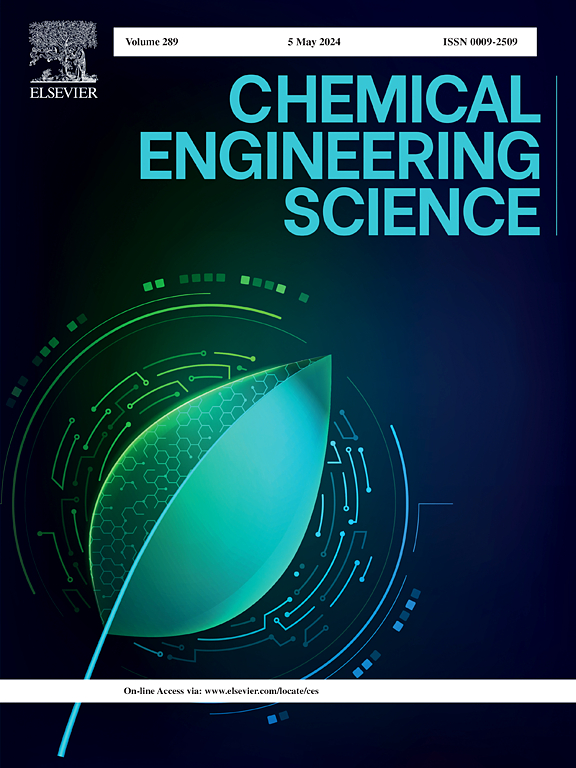耦合旋流场对纳米纤维微球的制备及聚结性能的影响
IF 4.1
2区 工程技术
Q2 ENGINEERING, CHEMICAL
引用次数: 0
摘要
液滴聚结在工业生产过程中有着广泛的应用。基于纤维聚结理论,提出了一种利用纳米纤维微球与旋流场耦合增强纤维聚结性能的新方法。系统研究了明胶/聚乳酸纳米纤维微球的制备工艺,探讨了影响其形貌和粒径的关键因素。采用SEM、ATR-FTIR、DSC和接触角测试对纳米纤维微球进行了全面表征,并分析了不同操作参数对纳米纤维微球聚结性能的影响。结果表明,通过优化交联温度和电喷涂参数,可以有效控制明胶/聚乳酸纳米纤维微球的形貌和粒径。热交联改变了微球的分子间相互作用和化学基团分布,明胶与聚乳酸的质量比显著影响了微球的热性能和润湿性。随着交联温度的升高,水接触角逐渐增大,在190 ℃时达到最大值160°。当明胶含量达到75% %时,水下超疏油性增强(油接触角为168°)。聚结性能实验表明,纳米纤维微球的引入显著增强了油滴在旋流场中的聚结效果,油滴的体积平均直径从21.52 μm增加到47.88 μm,增加了2.2倍。研究结果对揭示旋流场内聚结机理和设计高效的聚结增强旋流分离装置具有重要的指导意义。本文章由计算机程序翻译,如有差异,请以英文原文为准。
Preparation of nanofiber microspheres and investigation of coalescence performance enhanced by the coupled swirling flow field
Droplet coalescence is widely applied in industrial production processes. Based on the theory of fiber coalescence, a novel method for enhance coalescence performance by nanofiber microspheres coupled with swirling flow field was proposed in this paper. The preparation process of gelatin/PLA nanofiber microspheres was systematically studied, and the key factors influencing their morphology and particle size were explored. The nanofiber microspheres were comprehensively characterized using SEM, ATR-FTIR, DSC, and contact angle measurements, and the effects of different operating parameters on coalescence performance were analyzed. The results showed that by optimizing the crosslinking temperature and electrospraying parameters, the morphology and particle size of gelatin/PLA nanofiber microspheres can be effectively controlled. Thermal crosslinking altered the intermolecular interactions and chemical group distribution of the microspheres, and the mass ratio of gelatin to PLA significantly affected their thermal properties and wettability. As the crosslinking temperature increased, the water contact angle gradually increased, reaching a maximum of 160° at 190 °C. When the gelatin content reached 75 %, the underwater superoleophobicity enhanced (oil contact angle was 168°). Coalescence performance experiments demonstrated that the introduction of nanofiber microspheres significantly enhanced the coalescence effect of oil droplets in the swirling flow field, and the Volume average diameter of oil droplets increased from 21.52 μm to 47.88 μm, which increased by 2.2 times. The findings provide important guidance for revealing the coalescence mechanism in the swirling flow field and designing efficient coalescence-enhanced swirl separation devices.
求助全文
通过发布文献求助,成功后即可免费获取论文全文。
去求助
来源期刊

Chemical Engineering Science
工程技术-工程:化工
CiteScore
7.50
自引率
8.50%
发文量
1025
审稿时长
50 days
期刊介绍:
Chemical engineering enables the transformation of natural resources and energy into useful products for society. It draws on and applies natural sciences, mathematics and economics, and has developed fundamental engineering science that underpins the discipline.
Chemical Engineering Science (CES) has been publishing papers on the fundamentals of chemical engineering since 1951. CES is the platform where the most significant advances in the discipline have ever since been published. Chemical Engineering Science has accompanied and sustained chemical engineering through its development into the vibrant and broad scientific discipline it is today.
 求助内容:
求助内容: 应助结果提醒方式:
应助结果提醒方式:


